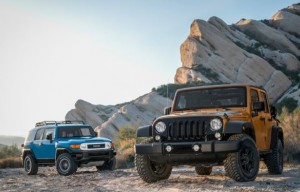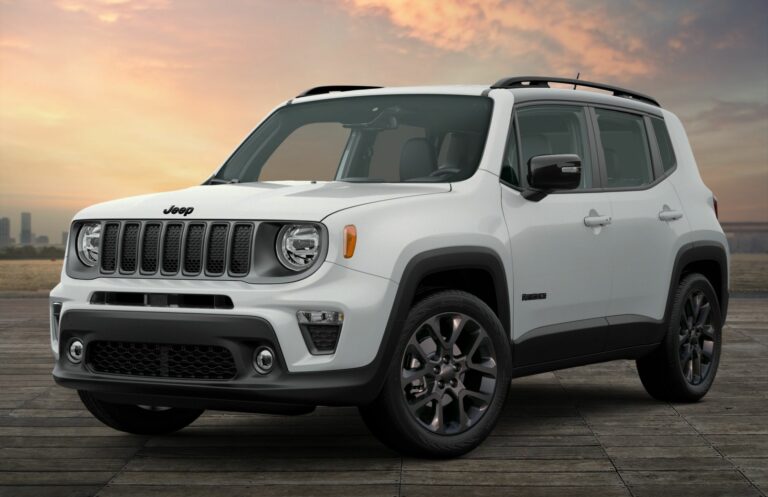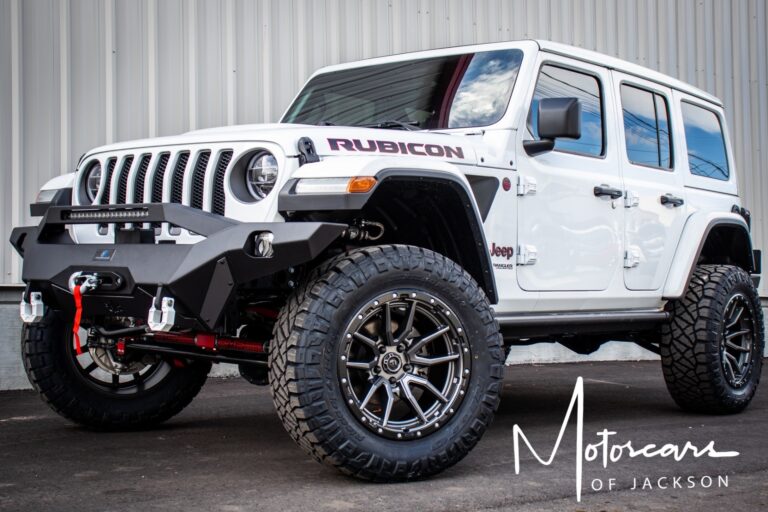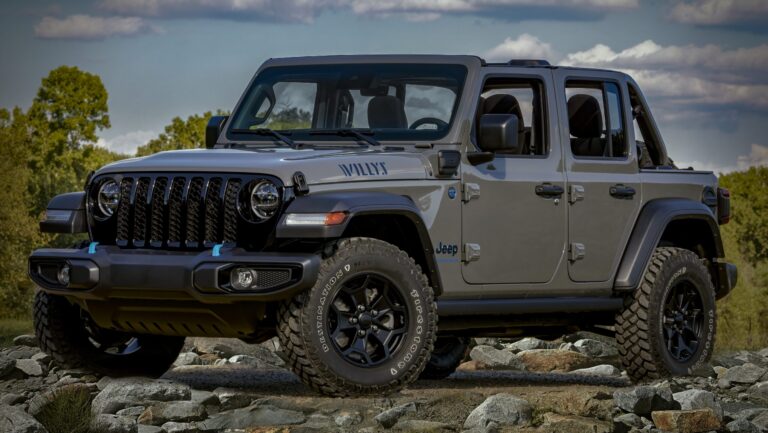Wrangler Jeep Vs FJ Cruiser: The Ultimate Off-Road Showdown
Wrangler Jeep Vs FJ Cruiser: The Ultimate Off-Road Showdown jeeps.truckstrend.com
In the rugged world of off-road vehicles, few names command as much respect and passion as the Jeep Wrangler and the Toyota FJ Cruiser. These two titans represent distinct philosophies in conquering the untamed wilderness, each boasting a loyal following and a formidable reputation for capability. For adventurers, weekend warriors, and daily commuters alike, choosing between these iconic machines is a decision fraught with exciting possibilities and practical considerations. This comprehensive guide aims to dissect the Wrangler Jeep vs FJ Cruiser debate, providing a detailed comparison to help you navigate their unique strengths, weaknesses, and overall ownership experiences.
A Legacy of Off-Road Prowess: A Brief History
Wrangler Jeep Vs FJ Cruiser: The Ultimate Off-Road Showdown
Before diving into the nitty-gritty, understanding the heritage of these vehicles is crucial.
Jeep Wrangler: The Wrangler is a direct descendant of the original Willys MB, the legendary military vehicle that helped win World War II. Its lineage is steeped in utilitarian design, rugged simplicity, and unparalleled off-road prowess. Over decades, the Wrangler has evolved through various generations (CJ, YJ, TJ, JK, JL), but has consistently maintained its core identity: a body-on-frame SUV with solid axles, removable doors and roof, and an unmistakable, iconic silhouette. It embodies the spirit of freedom and adventure, designed from the ground up to tackle the most challenging terrains.
Toyota FJ Cruiser: The FJ Cruiser, while a more modern creation, pays homage to the revered Toyota Land Cruiser FJ40, a global workhorse from the mid-20th century. Launched in 2006, the FJ Cruiser aimed to capture the retro charm and legendary durability of its ancestor, blending it with modern Toyota reliability and off-road technology. While its production run in North America ceased in 2014 (though it continued in other markets until recently), its unique styling and robust capabilities have cemented its status as a cult classic and a highly sought-after used vehicle.
Design & Aesthetics: Form Meets Function (and Nostalgia)
The visual identities of the Wrangler and FJ Cruiser are as distinct as their origins.
Jeep Wrangler: The Wrangler’s design is unapologetically functional and instantly recognizable. Its boxy shape, flat fenders, round headlights, and seven-slot grille are design cues that have been refined over decades. The true magic, however, lies in its modularity: removable doors, a fold-down windshield, and various convertible soft or hardtop options offer an unparalleled open-air driving experience. Inside, the design is rugged and utilitarian, prioritizing durability and ease of cleaning, though recent generations (JL) have introduced more creature comforts and modern tech. Customization is a core part of the Wrangler experience, with an aftermarket industry that dwarfs almost any other vehicle.
Toyota FJ Cruiser: The FJ Cruiser’s design is a bold blend of retro and futuristic elements. Its wide stance, short wheelbase, white roof (on many models), and distinct grille with "Toyota" spelled out (rather than the logo) are direct callbacks to the FJ40. Its unique "suicide" rear doors (which open opposite the front doors) provide access to the rear seats but require the front doors to be open first. The interior features durable, water-resistant fabrics and rubberized flooring, designed for easy cleanup after adventures. While its styling is polarizing, it undeniably stands out from the crowd. Unlike the Wrangler, its external design is less conducive to extensive modification, though lift kits and larger tires are common.
Performance & Drivetrain: The Heart of the Beast

Both vehicles are built for adventure, but their approaches to power and capability differ.
Jeep Wrangler: Modern Wranglers offer a diverse powertrain lineup. The venerable 3.6L Pentastar V6 (285 hp, 260 lb-ft) remains a popular choice, offering a good balance of power and reliability. A 2.0L turbocharged inline-four (270 hp, 295 lb-ft) provides excellent low-end torque. For ultimate power, the limited-production Rubicon 392 packs a 6.4L HEMI V8 (470 hp, 470 lb-ft). The innovative Wrangler 4xe combines a 2.0L turbo engine with two electric motors, offering 375 hp, 470 lb-ft, and significant all-electric range. Transmissions include an 8-speed automatic or a 6-speed manual (on select trims).
Off-road, the Wrangler is a legend. Its solid front and rear axles provide exceptional articulation, allowing wheels to stay in contact with uneven terrain. The available Rock-Trac 4×4 system on Rubicon models features a 4:1 low-range gear ratio, Tru-Lok electronic locking differentials, and an electronic sway bar disconnect for maximum wheel travel. Approach, departure, and breakover angles are among the best in the industry.
Toyota FJ Cruiser: The FJ Cruiser was primarily offered with a robust 4.0L 1GR-FE V6 engine (239 hp, 278 lb-ft in later models), paired with a 5-speed automatic or a 6-speed manual transmission (the latter was rarer). This engine is renowned for its durability and smooth power delivery, though it’s not as powerful as some of the Wrangler’s modern options.
The FJ Cruiser’s off-road capability is impressive, built on a modified ladder frame chassis shared with the 4Runner and Tacoma. It features an excellent four-wheel-drive system with a low-range transfer case, an available locking rear differential, and Toyota’s A-TRAC (Active Traction Control) system, which uses braking to send power to wheels with traction. Its generous ground clearance, short overhangs, and robust suspension make it highly capable on trails, though its independent front suspension offers less articulation than the Wrangler’s solid axle setup.

On-Road Manners: While both are off-road focused, the FJ Cruiser generally offers a more refined and stable on-road ride, with less body roll and better high-speed stability than the Wrangler, especially older generations. The Wrangler, particularly the two-door, can feel a bit more unsettled at highway speeds due to its solid axles and higher center of gravity, though the JL generation has significantly improved on-road comfort and handling.
Practicality & Versatility: More Than Just Off-Roaders
Beyond the trails, how do these vehicles fare in daily life?
Seating & Access: The Wrangler is available in two-door (four-seater) and four-door (five-seater) configurations, with the four-door being significantly more practical for families. The FJ Cruiser is technically a four-door, but its unique rear "suicide" doors and limited rear legroom make rear access and comfort less ideal for adults on long journeys.
Cargo Space: The Wrangler 4-door offers decent cargo space, especially with the rear seats folded. The 2-door Wrangler has very limited cargo room. The FJ Cruiser provides a good amount of cargo space, particularly with the rear seats folded flat, and its rear door swings out with an attached spare tire, making for easy loading.

Towing Capacity: Both vehicles offer respectable towing capacities. The Wrangler (4-door) can typically tow up to 3,500 lbs (or 5,000 lbs on specific trims like the Rubicon 392 or with specific packages), while the FJ Cruiser is rated for 5,000 lbs.
Daily Driving & Fuel Economy: The FJ Cruiser, with its more stable on-road demeanor, often makes for a slightly more comfortable daily driver, especially considering its age. The Wrangler, particularly the 4-door JL, has improved significantly in daily usability, but its off-road focus means compromises in ride quality and noise levels compared to more car-like SUVs. Fuel economy for both is not a strong suit; expect figures in the mid to high teens (MPG). The Wrangler 4xe offers a significant advantage with its plug-in hybrid efficiency for shorter commutes.
Safety & Technology: Modern Comforts in Rugged Machines
Given the FJ Cruiser is no longer new, its tech suite is naturally older.
Jeep Wrangler (JL Generation): Modern Wranglers come with a range of contemporary safety features, including multiple airbags, ABS, traction control, and electronic stability control. Available advanced driver-assistance systems (ADAS) include blind-spot monitoring, rear cross-path detection, forward collision warning, and adaptive cruise control, though these are typically optional or limited to higher trims. Infotainment systems feature Uconnect with available Apple CarPlay and Android Auto, larger touchscreens (up to 12.3 inches), and advanced navigation.
Toyota FJ Cruiser: The FJ Cruiser’s safety features are more basic, typical of vehicles from its era: front and side curtain airbags, ABS, electronic brake-force distribution, and stability control. No advanced ADAS features were offered. Its infotainment was basic, often an AM/FM/CD player, though many owners upgrade to aftermarket head units for modern connectivity.
Ownership Experience & Resale Value
Reliability & Maintenance: Toyota’s reputation for reliability is legendary, and the FJ Cruiser lives up to it. Its drivetrain is robust and known for lasting hundreds of thousands of miles with proper maintenance. Parts are generally affordable and widely available. Jeep’s reliability has historically been a point of contention for some, but recent generations have shown improvements. The aftermarket for the Wrangler is enormous, meaning parts, accessories, and specialized mechanics are abundant, which can sometimes make repairs and modifications more accessible, albeit potentially more frequent.
Aftermarket & Customization: This is where the Wrangler truly shines. Its modular design and immense popularity have fostered an aftermarket industry unlike any other. Owners can customize everything from suspension and tires to body panels and interior components, transforming their Wrangler into anything from a hardcore rock crawler to an overland expedition vehicle. The FJ Cruiser also has a strong aftermarket following for off-road modifications (lifts, bumpers, armor), but it’s not as extensive or diverse as the Wrangler’s.
Resale Value: Both vehicles hold their value exceptionally well. The FJ Cruiser, due to its discontinuation and cult status, has seen its used prices remain remarkably high, often appreciating in certain markets. The Wrangler, with its timeless appeal and continuous demand, also boasts some of the best resale values in the automotive industry, especially for well-maintained or modified examples.
Key Considerations for Buyers: Choosing Your Adventure
The choice between a Wrangler and an FJ Cruiser ultimately boils down to your priorities.
-
Intended Use:
- Serious Off-Roading & Customization: The Wrangler, particularly Rubicon trims, offers superior articulation and out-of-the-box capability for extreme rock crawling and highly technical trails. Its modularity allows for endless customization to suit specific off-road needs.
- Reliable Overland & Mild-to-Moderate Trails: The FJ Cruiser excels as a durable, reliable overlander and a highly capable vehicle for moderate to challenging trails. Its robust powertrain and Toyota reliability make it an excellent choice for long-distance adventures where breakdowns are unacceptable.
- Daily Driving Balance: The FJ Cruiser, while older, often provides a slightly more comfortable and stable on-road experience. However, the latest Wrangler JL has significantly closed this gap, offering a much more refined daily drive than its predecessors.
-
Budget:
- New Vehicle: Only the Wrangler is available new. Prices vary wildly by trim and options.
- Used Vehicle: Both command strong used prices. The FJ Cruiser’s rarity means it can be expensive, especially for low-mileage examples. Used Wranglers are plentiful but also hold value well.
-
Aesthetics & Style: Do you prefer the classic, rugged, and customizable look of the Wrangler or the unique, retro-futuristic charm of the FJ Cruiser?
-
Open-Air Experience: If removing the roof and doors is a must-have, the Wrangler is your only option.
Price Table: Wrangler Jeep vs. FJ Cruiser (Estimated)
It’s crucial to note that the FJ Cruiser is no longer sold new in most major markets. The prices for the FJ Cruiser below reflect estimated used market values for well-maintained models, while the Wrangler prices are estimated new MSRPs for the 2024 model year in the US market. Prices can vary significantly based on trim, condition, mileage, location, and optional features.
| Feature | Jeep Wrangler (2024 New, Est. MSRP) | Toyota FJ Cruiser (Used, Est. 2010-2014 Model Year) |
|---|---|---|
| Model/Trim | Sport S 2-Door | Base Model (4×4) |
| Engine | 3.6L Pentastar V6 / 2.0L Turbo I4 (Optional) | 4.0L V6 (1GR-FE) |
| Horsepower | 285 hp (V6) / 270 hp (Turbo I4) | 239 hp (later models) |
| Torque | 260 lb-ft (V6) / 295 lb-ft (Turbo I4) | 278 lb-ft |
| Transmission | 6-Speed Manual / 8-Speed Automatic | 5-Speed Automatic / 6-Speed Manual (Rarer) |
| Est. MPG (Combined) | 19-21 MPG (V6/Turbo I4) | 16-18 MPG |
| Base MSRP/Used Price Range | $35,000 – $45,000 | $25,000 – $45,000+ (Highly variable based on mileage, condition, modifications, and year) |
| Key Features | Part-time 4×4, Solid Axles, Removable Doors/Roof/Windshield, Uconnect Infotainment | Full-time 4×4 (manual trans) / Part-time 4×4 (auto trans), Locking Rear Diff (optional), A-TRAC, Retro Styling, Suicide Rear Doors |
| Model/Trim | Rubicon 4-Door | Trail Teams Edition / Special Edition (Used) |
| Engine | 3.6L Pentastar V6 / 2.0L Turbo I4 / 6.4L V8 (392) / 2.0L Turbo PHEV (4xe) | 4.0L V6 (1GR-FE) |
| Horsepower | 285 hp (V6) / 270 hp (Turbo I4) / 470 hp (392) / 375 hp (4xe) | 239 hp (later models) |
| Torque | 260 lb-ft (V6) / 295 lb-ft (Turbo I4) / 470 lb-ft (392) / 470 lb-ft (4xe) | 278 lb-ft |
| Transmission | 8-Speed Automatic (most common) | 5-Speed Automatic |
| Est. MPG (Combined) | 19-21 MPG (Gas) / 20 MPG + 21 miles electric range (4xe) | 16-18 MPG |
| Base MSRP/Used Price Range | $55,000 – $85,000+ (Higher for Rubicon 392 & 4xe) | $35,000 – $60,000+ (Premium for rare colors, low mileage, excellent condition) |
| Key Features | Rock-Trac 4×4 (4:1 low range), Electronic Locking Diffs (front/rear), Electronic Sway Bar Disconnect, Larger Tires, Robust Skid Plates | Enhanced Off-Road Features (often includes lifted suspension, specific tires, unique badging, rock rails, sometimes specific interior accents) |
Note: FJ Cruiser prices are highly speculative and depend heavily on the specific year, mileage, condition, and regional market demand.
Frequently Asked Questions (FAQ)
Q1: Is the Toyota FJ Cruiser still being produced?
A1: No, the Toyota FJ Cruiser ceased production for the North American market in 2014. It continued to be sold in some international markets (like the Middle East and Australia) until recently (around 2022-2023), but it is no longer produced globally.
Q2: Which vehicle is better for daily driving?
A2: Generally, the FJ Cruiser offers a slightly more stable and quieter on-road experience due to its independent front suspension. However, the latest generation Jeep Wrangler JL has significantly improved its on-road manners and offers more modern comfort features and technology, making it a much more viable daily driver than its predecessors.
Q3: Which is more reliable, the Wrangler or the FJ Cruiser?
A3: Toyota has a long-standing reputation for bulletproof reliability, and the FJ Cruiser lives up to that. Its 4.0L V6 engine and drivetrain are known to be incredibly durable. While modern Wranglers have improved, the FJ Cruiser is often considered the more reliable long-term choice, particularly for older models.
Q4: Can I remove the doors and roof on an FJ Cruiser?
A4: No, unlike the Jeep Wrangler, the doors and roof of the FJ Cruiser are not designed to be removed. The Wrangler offers a unique open-air driving experience that the FJ Cruiser cannot replicate.
Q5: Which is better for extreme off-roading like rock crawling?
A5: For extreme off-roading and highly technical rock crawling, the Jeep Wrangler (especially Rubicon trims) typically holds an edge. Its solid axles provide superior articulation, and features like electronic sway bar disconnects and front/rear locking differentials give it an advantage in very challenging terrain.
Q6: How do their fuel economies compare?
A6: Neither vehicle is known for great fuel economy. Both the gas-powered Wrangler and the FJ Cruiser typically achieve combined MPG figures in the mid to high teens. The Wrangler 4xe plug-in hybrid offers a significant advantage in fuel efficiency for shorter, electric-powered commutes.
Conclusion
The Jeep Wrangler and the Toyota FJ Cruiser stand as formidable contenders in the off-road arena, each with a distinct personality and an impressive set of capabilities. The Jeep Wrangler is the ultimate expression of off-road freedom and customization, offering unmatched open-air adventures and a robust platform for extreme modifications. It’s a vehicle that begs to be pushed to its limits on the trail and provides a unique, immersive driving experience.
The Toyota FJ Cruiser, a revered classic, offers legendary Toyota reliability, a distinctive retro aesthetic, and serious off-road prowess in a package that often feels a bit more refined on the pavement. It’s a fantastic choice for those seeking a highly durable, capable, and somewhat rare adventure vehicle that can confidently tackle most trails and serve as a dependable daily driver.
Ultimately, the choice between the Wrangler Jeep vs FJ Cruiser is a personal one, driven by your specific needs, aesthetic preferences, and how you envision your adventures unfolding. Do you prioritize raw, customizable off-road capability and the iconic open-air experience, or do you lean towards Toyota’s renowned reliability, unique styling, and robust, if slightly less extreme, trail performance? Both are exceptional in their own right, promising countless miles of adventure wherever the road (or lack thereof) takes you.







